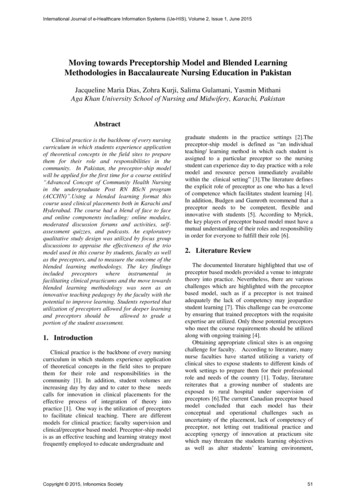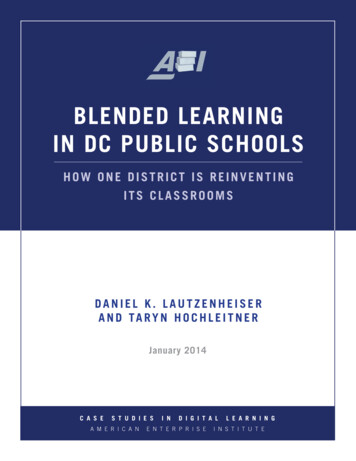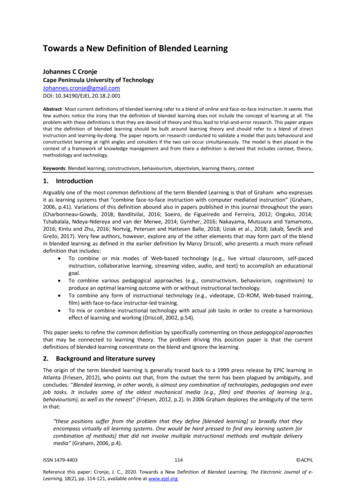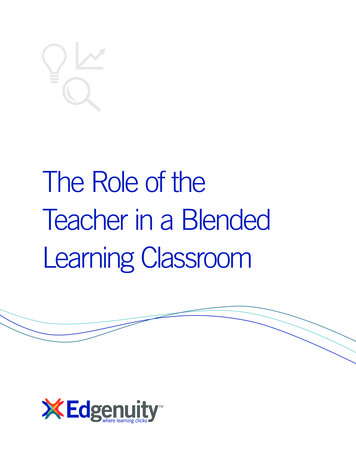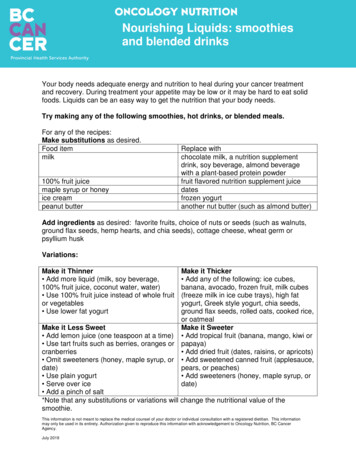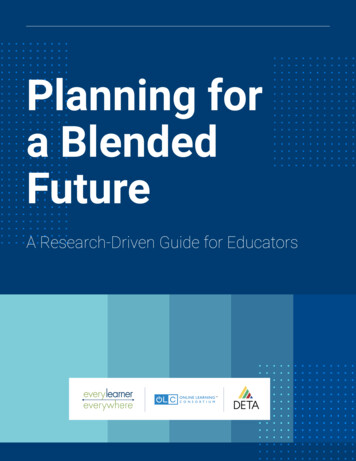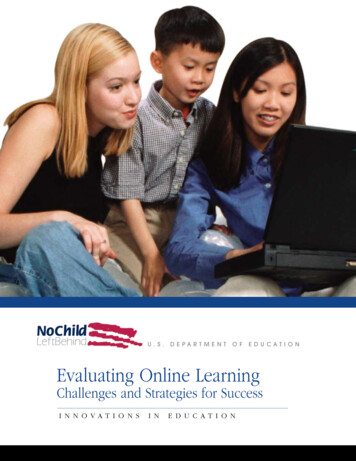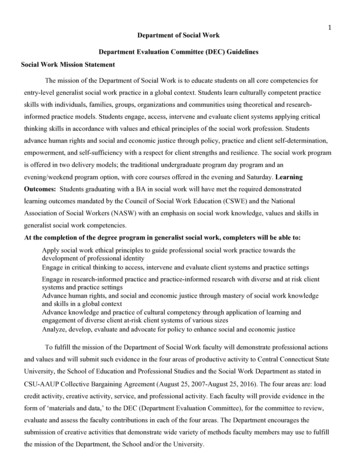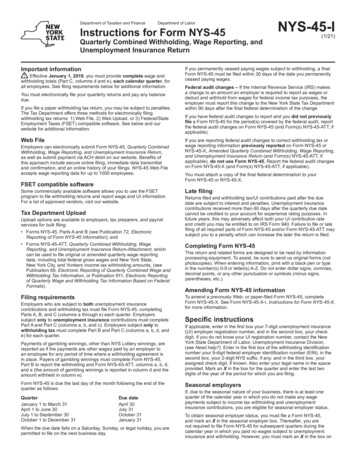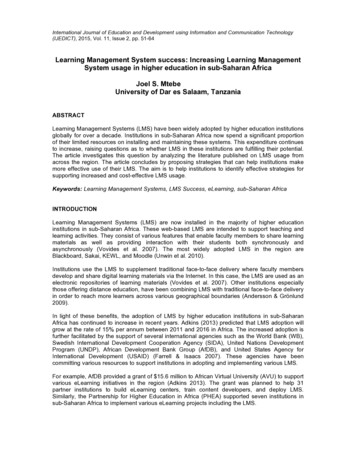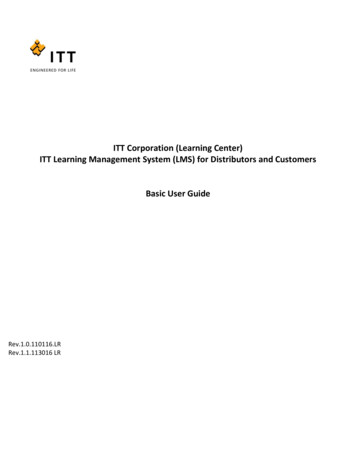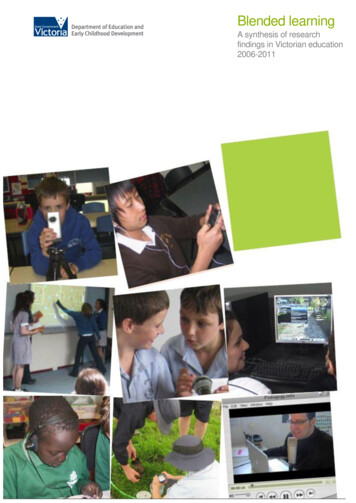
Transcription
Blended learningA synthesis of researchfindings in Victorian education2006-2011
Published by theUltranet and Digital Learning BranchDepartment of Education andEarly Childhood DevelopmentMelbourneMarch 2012 State of Victoria (Department of Educationand Early Childhood Development) 2012The copyright in this document is owned by the State of Victoria(Department of Education and Early Childhood Development), or inthe case of some materials, by third parties (third party materials). Nopart may be reproduced by any process except in accordance with theprovisions of the Copyright Act 1968, the National Education AccessLicence for Schools (NEALS) (see below) or with permission.An educational institution situated in Australia which is not conductedfor profit, or a body responsible for administering such an institutionmay copy and communicate the materials, other than third partymaterials, for the educational purposes of the institution.Authorised by the Department of Educationand Early Childhood Development,2 Treasury Place, East Melbourne, Victoria, 3002.This document is available atwww.education.vic.gov.au/researchinnovation/
ContentsForeword31.Introduction32.What is Blended Learning?52.1 Blended Learning Defined52.2 Blended Learning Defined in the Victorian Context62.3 Blended Learning Defined in a National and InternationalContext6What does blended learning look like?73.1 Blended Learning Formats73.2 Designing Blended Learning Activities93.3 Interaction103.4 Is Blended Learning for Everybody?12Blended Learning in Action – Victorian Case Studies14CASE STUDY 1: Chinese Language Learning With Web 2.014CASE STUDY 2: Ping Online Music Education Project153.4.CASE STUDY 3: National Gallery of Victoria Floating World Project165.CASE STUDY 4: Collaborative Rural Research Trials18CASE STUDY 5: VCE e-Biology Project19CASE STUDY 6: The Victorian Virtual Learning Network20CASE STUDY 7: The Wimmera Rural and Remote Project20The Benefits of a Blended Learning Approach225.1 Learning Outcomes225.2 Changes in Student Practices, Behaviours and Attitudes245.3 Teacher Factors265.4 Community and Expert Involvement - Intercultural and CulturalOpportunities275.5 Addressing Disadvantage285.6 The Advantages of Blended Learning29
Contents continued6.Challenges in Implementing Blended Learning Strategies306.1Developing Blended Learning Pedagogy306.2Teacher Support and Professional Development316.3Technological Challenges316.4Student Preparation / Support / Transition326.5Assessment Considerations336.6Culture and Innovation337.Summary and Conclusions348.Moving forward358.1 Considerations at a whole school level358.2 Considerations for Teachers358.3 Considerations for Students358.4 Technology Considerations35List of Schools369.References 39
ForewordVictoria as a Learning Community, - Extended Special Lecture (Department ofEducation and Early Childhood Development, 2011) articulates theGovernment‟s goal of improving student outcomes and empowering ourchildren and young people to thrive throughout their lives. This aligns with theMelbourne Declaration on Educational Goals for Young Australians(Ministerial Council on Education, Employment, Training and Youth Affairs,2008) which aims to have all young Australians develop into confident,creative and successful learners.Globalisation and technology are continually altering our views of educationand offering new opportunities for learning and engagement in life.Technology such as web conferencing, the Ultranet, blogs/wikis, virtual worldsand online gaming and mobile devices such as iPads, mobile phones, digitalcameras and voice recorders are changing the way teachers teach and theway students learn.Technology enables learning to extend beyond the classroom walls andfacilitates better access to learning resources. It also supports the creation ofpartnerships with the wider school community and equips learners withcontemporary skills necessary for successful participation in life.Blended learning approaches have amplified the need for school leaders,teachers, students and the wider community to take advantage of learningopportunities afforded through improved personalisation, collaboration, andcommunication enabled by learning technologies.Blended learning has many different forms and will continue to evolve as newtechnology and practices are introduced. It should not be viewed as a singlemodel but as an approach that shares the ultimate goal of the provision ofbetter educational experiences and outcomes.This publication provides teachers and principals with definitions, benefits andexemplars of the use of blended learning in the Victorian education context.I trust you will find this both informative and useful.Dr Jim WatterstonDeputy SecretarySchool Education Group3Blended learning:A synthesis of research findings in Victorian education 2006-2011
1.IntroductionThis paper is a synthesis of project work undertaken between 2006 and 2011by the Victorian Department of Education and Early Childhood Development(DEECD). It provides an overview of blended learning definitions and models,and includes some examples of blended learning activities and projectsconducted in Victorian Government schools. It concludes with someconsiderations for the future implementation and/or maximisation of learningopportunities from such approaches in Victorian schools.We live in a connected world with unparalleled access to a vast array ofonline information and experiences. Our children are growing up in a worldwhere excitement and opportunities are just a screen touch away.For many educators and trainers, a blended learning approach providesinnovative educational solutions through an effective mix of traditionalclassroom teaching with mobile learning and online activities.But what is “Blended Learning” and what does it mean for students, teachers,parents, school principals and the Victorian education system? How do weharness these resources to enrich the educational experiences for ourstudents? How do we tap into this knowledge bank to provide relevanteducation and vocational training experiences for our youth? Can we use thisconnectivity to build online communities for isolated students and adults inrural and remote areas? Does this technology have the potential to overcomedisabilities and provide equality of educational opportunity for all? Can we useblended learning approaches to deliver professional development to all ourteachers and school administrators? Can traditional assessment tools be usedwith blended learning? Will a blended learning approach require extraresources to be provided by schools and/or the education system? Willparents be convinced their children are receiving a „proper‟ education?Since 2010, the release of the Ultranet, a secure site for managing learningand collaboration between students, teachers and parents available to allVictorian Government schools, has placed a greater imperative for teachers tooptimise blended learning opportunities in teaching and learning andmaximise the potential for the online learning it provides.In the following pages you will find definitions of blended learning anddescriptions of blended learning environments; anecdotes and case studiesfrom blended learning activities; research findings about the advantages andbenefits of a blended learning approach in Victoria; and some of thechallenges to be faced when implementing blended learning.Introduction4
2.What is Blended Learning?2.1 Blended Learning DefinedWhat is Blended Learning and why is it so hard to achieveconsensus on its definition?Historically, classroom teachers in Victoria, and indeed throughout Australia,have used a range of learning activities and resources to assist learners toachieve learning objectives. Face-to-face presentations, visual material,paper-based assessments, online research and group activities have been themainstay of classroom teaching for many decades. More recently mobiletechnologies and collaborative Web 2.0 tools have expanded opportunities forlearning.Blended learning is really no more than a combination of all of theseapproaches.For some teachers, blended learning is describing what they‟ve been doingsuccessfully for years: that is, using a range of resources and activities toprovide individualised, student-centred learning experiences for their students.The real difference today is the unparalleled access to the internet with its richsources of information and services and more importantly, the connectivity itoffers students and teachers, particularly the ability to create onlinecommunities and support networks. In addition, there is a growing use ofmobile technologies such as flip cameras, voice recorders, mobile phones andGPS devices extending learning beyond the classroom walls.For other teachers, blended learning represents a challenge. They are notcomfortable with nor do they fully understand the technologies and media thattheir students use every day, or the potential that these can offer theirlearners.To assist teachers in implementing blended learning activities, this paperreinforces the concept that blended learning comes in many guises and isn‟t a“one-size-fits-all” educational solution.Definitions of blended learning range from the very broad where practicallyany learning experience that integrates some use of ICTs qualifies, to othersthat focus on specific percentages of online curriculum and face-to-faceinstruction.Most people agree that blended learning combines teaching and learningmethods from both face-to-face, mobile and online learning and that itincludes elements of both synchronous and asynchronous online learningoptions.The integration of new mobile technologies and online media is proving highlyeffective in helping schools meet the expectations of 21st century learnerswhile addressing the challenges of limited resources and the special needs ofmany students.However, not everyone is happy with the term blended learning. Oliver andTingwell (2003) in their article „Can blended learning be redeemed?‟ arguethat blended learning is ill-defined and muddled as a description of particularforms of teaching with technology. They argue that the term blended learningmay be redundant and gratuitous, as the practice of mixing traditionalclassroom methods with technology is widespread.This summary acknowledges that a broad continuum of definitions exists andthat its definition will continue to evolve in the literature as new technology andassociated skill sets emerge. This paper takes a practical approach to defining5Blended learning:A synthesis of research findings in Victorian education 2006-2011
blended learning based on the Victorian experience and will demonstrate thebenefits from such flexible approaches.“Ultimately, the exact definition of blended learning, beyond somecombination of online and face-to-face, may not matter.”International Association for K-12 Online Learning (2008)2.2 Blended Learning Defined in the VictorianContextBased on projects and teaching practice in Victorian schools, blendedlearning refers to the planned implementation of a learning model thatintegrates student-centred, traditional in-class learning with other flexiblelearning methodologies using mobile and web-based online (especiallycollaborative) approaches in order to realise strategic advantages for theeducation system.These advantages might include cost benefits, increased access toeducational opportunities, flexibility of workforce deployment, and so on.2.3 Blended Learning Defined in a National andInternational Context“The concept of blended learning is rooted in the idea that learning is not justa one-time event—learning is a continuous process. Blending providesvarious benefits over using any single learning delivery medium alone.”.Singh (2003)Around Australia, educators have similar definitions for blended learning.The Tasmanian Department of Education e-School (2011) defines blendedlearning as „a range of learning opportunities, e.g. online, face-to-face,community and home to achieve curriculum diversity and promote studententhusiasm‟In 2003, the Australian National Training Authority (ANTA) described blendedlearning in Australia as „the integrated combination of traditional learning withweb-based online approaches‟. These simple, practical definitions aresupported by eminent researchers who have defined blended learning as„essentially traditional in-class learning supplemented by online activities andresources‟ ( Downes, 2008) and „blended learning is currently conceived asthe combination of technology and traditional face to face instruction.‟ (Stacey.and Mackey, 2009)In the US, the International Association for K-12 Online Learning (2008)follows a similar line with its definition: „In general terms, blended learningcombines online delivery of educational content with the best features ofclassroom interaction and live instruction to personalise learning, allowthoughtful reflection, and differentiate instruction from student to studentacross a diverse group of learners.‟“Blended learning should be viewed as a pedagogical approach thatcombines the effectiveness and socialisation opportunities of the classroomwith the technologically enhanced active learning possibilities of the onlineenvironment, rather than a ratio of delivery modalities.”Dziuban, Hartman and Moskal (2004)What is Blended Learning?6
3.What does blended learning looklike?3.1 Blended Learning FormatsSome blended learning practitioners worry about the appropriate allocation oftime between traditional face-to-face teaching and learning, and extendinglearning beyond the classroom walls with mobile and online technologies.The actual percentage of time allocated or the blending of the differentactivities and approaches is not important. What is important is finding theright mix or blend that serves each student‟s needs.In Victorian schools, blended learning comes in many guises although eachapplication has the essential ingredients of classroom delivery plus mobilelearning and web content with the added inclusion of interaction withcommunity members and other subject matter experts plus opportunities forsharing and learning with peers.In essence, there is a blending of flexible teaching and learning approachesthat include student-teacher, student-student, student-community interactionsand feedback.The projects described below were derived from the Innovating withTechnologies (IWT) research projects (2008-2011) exploring the impact of ICTon student learning outcomes.Stories From Around A Campfire (2010)This project sought to improve the speaking and listening skills of Prep toYear 2 students in three rural schools, in the Loddon Campaspe Region ofVictoria. The schools involved used Skype, blogs, interactive whiteboards, flipcameras, webcams, digital cameras and email to improve communicationskills of learners. The project provided situations that encouraged orallanguage development and provided authentic student-student feedback.7Blended learning:A synthesis of research findings in Victorian education 2006-2011
“The strength of using the flip cameras and Skype was that it providedopportunities for the students to observe themselves and to self-evaluate aswell as receive feedback from peers”.Teacher, Stories From Around a Campfire (2010)Ping (2009)Walking into any of the five rural school classroom spaces when the Ping(2009) music education project was running, a visitor would have witnessedthe use of virtual delivery approaches to enhance young people‟s involvementin music. In this IWT project students developed their own music compositionusing synchronous professional guidance from Melbourne SymphonyOrchestra musicians. Communication took place using web conferencingtechnology.Sharing Our Environment (2010)This was an IWT project where Prep and Year 1 students at three primaryschools in the Barwon South West Region of Victoria used technology to allowstudents to communicate regularly, and co-create and share learnings withstudents in neighbouring rural communities whom they had never met. Thestudents used digital cameras, webcams with Skype, iPods, computers andsome environmental gadgets (rain gauges and bug catchers) to collect, shareand relay their learnings and experiences.Improving Literacy In ESL/ VCAL Students Undertaking WorkplaceLearning (2009)This was a North Geelong Secondary College IWT project using mobiletechnologies (iPods) to extend learning by a group of 10 students fromrefugee backgrounds undertaking their Victorian Certificate of AppliedLearning (VCAL) to assist them to gain self-confidence to improve theirlanguage acquisition. Students used the devices in their work placement tocomplete word tasks, document occupational health and safety issues; recordoral logs and reflections on their performance; and gather employer feedbackon their daily progress. The students‟ reflections and employer feedback werethen emailed to their classroom teacher for assessment.What does blended learning look like?8
3.2 Designing Blended Learning ActivitiesWell-designed blended learning models offer immediate advantages for theVictorian school system. However, current trials support the view that there isno one blended learning model that adequately meets the needs of each andevery learning community.The National Centre for Vocational Education Research Report One sizedoesn't fit all: Pedagogy in the online environment (Brennan, 2003) and themore recent report by the Department of Education, Employment andWorkplace Relations Exemplar Schools: Using Innovative LearningTechnologies (Holkner, Romeo, Henderson, Auld, Russell, Seah andFernando, 2008) both argue that the most successful blended learning modelsare ones which best meet all the demands of a local situation.“It is important to recognise that each Australian school is a unique learningcommunity made up of school leaders, teachers, students and parents.Each of these communities is influenced by a large number of factorsincluding, the socio-economic background of the students and parents, thegeographic location of the school, levels of government funding and ofcourse the quality of teachers and staff”.Holkner et al (2008)The authors of Issues in Digital Technology in Education: Blended Learning(Wikibooks, 2009) have identified four broad principles of education design forblended learning. These are: A thoughtful integration of face-to-face and fully online instructionalcomponents Innovative use of technology Re-thinking the way we teach Sustained assessment and evaluation of blended learning.According to Bonk and Graham (2006) in their Handbook of BlendedLearning, blended learning should be approached as a fundamental redesignof the instructional model with the following characteristics: A shift from teacher-centred to student-centred instruction in which studentsbecome active and interactive learners (this shift should apply to the entirecourse, including face-to-face contact sessions) Increases in interaction between student-teacher, student-student, studentcontent, and student-outside resources9Blended learning:A synthesis of research findings in Victorian education 2006-2011
Integrated formative and summative assessment mechanisms for studentsand teachers.Elements of these design principles are discernible in most Victorian blendedlearning projects discussed in the next section.3.3 InteractionResearch both in Victoria and elsewhere indicates that student satisfactionwith the blended format is directly dependent upon the level of interaction withteachers and other students. Teachers can increase interaction opportunitiesthrough face-to-face discussion sessions and by using online tools such asdiscussion forums, virtual conferencing, virtual world and online games, andusing mobile technologies such as flip cameras and voice recorders toengage with parents and the wider school community.Teacher-Student interactionPodcasting in the Classroom (2006)For this Wanganui Park Secondary College project a teacher created a seriesof VCE biology podcasts which were then posted to a website available fordownload.The website not only allowed people from all around the world to benefit fromthe information presented but also allowed the listeners to share theirtestimonials of how they have benefited. Teachers no longer needed to havetheir students in class with them in order for the students to be learning.Students can be presented with material (from the teacher and other students)via podcasts and can be involved in discussions about learning usingdiscussion boards, blogs and chat rooms outside of the classroom.See: http://biologyoracle.podomatic.com/This freed class time for richer, reflective and more creative activities whichengage students and help them to learn more deeply than has happenedpreviously. Because the bulk of content delivery was taking place out ofclass, the traditional idea of a class having one teacher was being challenged.Student-Student interactionSharing My Voice (2010)For this IWT project, Eltham High School students used iPods to listen to awide range of authentic French listening materials 1:1 at their own pace.Music, podcasts, and apps were sourced and students listened to theseWhat does blended learning look like?10
intensively. Having completed the listening component of the project, studentsthen created an audio book in which they were required to read the story theyhad written and record their version to the iPods. Drafting occurred using thedevices, and teacher and peer feedback was facilitated through the use of theiPods. Final story narration demonstrated clear improvement in the lower tomiddle band of student performance.The students then visited the local primary school and taught a French lessonto Preps 1:1 using the devices confirming their understanding of the contentand giving the Eltham High School students confidence in speaking anotherlanguage.Student-Content interactionHiragana, iPods And Japanese Character Recognition (2009)This was a Derrinallum P-12 School IWT project. The Japanese languageteacher developed a series of podcasts for the students‟ iPods to differentiatelearning (e.g. teach the Japanese characters to lower level students and tointroduce more complex Japanese Hiragana to the more advanced students).The vodcasts were supported by a range of iPod applications to encouragestudents to use their knowledge of hiragana. These included: online games,online dictionaries and quizzes.Student-Community interactionCreating Links within the Bayside Community (2010)This was a Sandringham College IWT project where students used GlobalPositioning System (GPS) devices and geocaching websites to find and hidecaches. The local historical society became involved and provided thestudents with local historical information. Students used a group wiki andindividual blogs for reflection. Students learnt to identify and hide caches(which required them to load the GPS information onto a geocaching website),and they learnt to research and investigate the historical significance of some11Blended learning:A synthesis of research findings in Victorian education 2006-2011
caches. The students checked the geocaching website for feedback on thecache, and to make improvements and maintain the cache. Students sharedtheir experiences and reflections on a weekly blog and their group Wikis.Students also developed stronger community links through the historicalsociety, interviewing members of the community and finding out the historicalimportance of the different areas of Sandringham. It gave them a sense ofpride and belonging to the local area.3.4 Is Blended Learning for Everybody?Blended learning comes in many shapes and sizes – there is no right way orwrong way, no correct formula or single “right” ratio of face-to-face, online timeand self-paced activities in and beyond the classroom. Each approach isbased on the needs of the students, the curriculum and the resourcesavailable.Victorian DEECD projects described here have been conducted with studentsfrom Prep to Year 12.Is Blended Learning Different from Distance Education?Distance education offers one form of blended learning.Traditionally distance education provision has been predominantly forstudents who through their geographical isolation have not been able toattend classes.Distance education providers were early adopters of ICT in education, notablythe various Schools of the Air with their use of radio, then video and now thefull range of communications and online technologies (including onlineconferencing, social media websites, wikis/blogs, email and virtual worlds).The increased integration of ICT, particularly Web 2.0 technology intodistance education provision has broadened the scope of delivery to includelearners who choose not to attend classroom education as well as those whodon‟t have the choice through their personal circumstances e.g. ill health.Blended Learning In the Early Years Classroom“While at times, it has been seen as controversial to use technology soregularly with Early Years students, the parents, students and widercommunity support the trend.”“The Prep students are now using appropriate language when working ingroups and during problem-solving and decision-making activities, whichwould be expected from more mature students. They are showingresponsibility and respect towards the school‟s and other‟s belongings andunderstand the consequences of each other‟s actions.”Teacher, Sharing Our Environment (2010)Blended Learning and RuralityRobotics for Rural (2008)This was an IWT project where teachers and students from eight small ruralschools in Gippsland worked with Year 5 and 6 students on using Legorobotics equipment to produce a Lego robotics program, with mentoring froma local secondary school via webcams.What does blended learning look like?12
“The implementation of the Lego Robotics program for any of our smallschools alone would have been a very large commitment in terms of theallocation of human resources and funding”.“The geographical spread of our eight cluster schools has meant thisprogram has built relationships for students and has been an importanttransition experience for secondary education”.Teacher, Robotics for Rural (2008)13Blended learning:A synthesis of research findings in Victorian education 2006-2011
4.Blended Learning in Action –Victorian Case StudiesBetween 2006 and 2011, the DEECD through its Innovation and Next PracticeDivision conducted a number of action research projects using ICTs designedto cater for specific cohorts of students and teachers where there was anidentified need or opportunity.The Emerging Technology (2006-2007), Innovating With Technologies(2008-2011), and KnowledgeBank: Next Generation (2008-9) trials were alldesigned to encourage the innovative use of ICTs in schools to improvestudent outcomes, build workforce capability and promote systemimprovement (DEECD 2010).The projects supported teachers in schools by building capacity to provide fullcurriculum coverage for all students and to work together to optimise learningopportunities for all students whilst minimising disadvantage (rural/remotestudents, indigenous students, students with disabilities, and disengagedlearners etc.).CASE STUDY 1: Chinese Language LearningWith Web 2.0 Project (KB:NG 2009)The Chinese language learning with Web 2.0 project investigated how Web2.0 technologies may facilitate and support the acquisition of Asian languages(in this case, Mandarin) in schools. Four teachers and 80 students in twoprimary and two secondary schools participated in the trial. Three of theschools were suburban schools with one rural secondary school. Thestudents comprised four classes – Year 5, Year 6, Year 7 and a mixed Year 9and 10 class.The participating teachers were asked to explore how the use of Web 2.0tools and technologies, when embedded within the curriculum, might affect: student learning outcomes, in listening and speaking, reading and writing student attitudes and levels of engagement student and teacher confidence and capability in using ICTs communication and collaboration between students and teachers changes in teacher practice that reflect learning needs of students ofMandarin Chinese the level of contact hours students have with the language and theincreased opportunities to be “immersed” in the language using Web 2.0technologies between classes.Blended Learning in Action – Victorian Case Studies14
The students used lessons and activities downloaded from a wiki, and gamesand videos sourced from the web. Students demonstrated their learning byproducing original audio, video and written texts, and these were uploaded toa social networking site (Ning) for sharing.The teachers had three online meetings via virtual classroom technologiesand kept in regular contact through phone and email. The meetings were heldas a forum for exchange of experiences and suggestions regarding technicalissues and good practice in managing student use of the online spaces.The findings included: student engagement, confidence and motivation to learn Chinese increased classroom behaviour improved with more students staying on task the school community, family and friends were able to get involved in thelearning increased interest in using Chinese to communicate with other learners andnative speakers a wiki served well as a resource centre especially for the younger studentsto get access to the audio and video resources beyond the languageclassroom students showed greater initiative and independent learning teachers increased their knowledge and confidence in Web 2.0 and ICT using new skills and creative activity gave teachers increased enjoyment inteaching.CASE STUDY 2: Ping Online Music EducationProject (IWT 2009)The Ping (2009) online music education project trialled new ways of deliveringmusic education using a blended learning approach.
The real difference today is the unparalleled access to the internet with its rich sources of information and services and more importantly, the connectivity it offers students and teachers, pa
